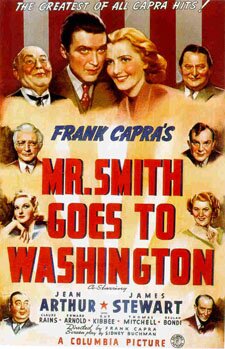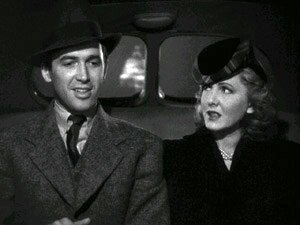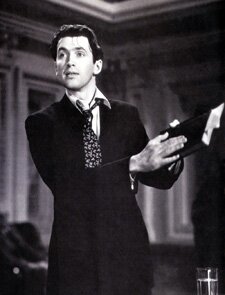Directed by Frank Capra
 I had forgotten how much in love with Jean Arthur I was. I remembered as I watched Mr. Smith Goes to Washington.
I had forgotten how much in love with Jean Arthur I was. I remembered as I watched Mr. Smith Goes to Washington.
Originally intended as a follow up to Mr. Deeds Goes to Town (and titled Mr. Deeds Goes to Washington), Gary Cooper, who was in the first film, couldn’t get released from his studio contract to do the movie so enter Jimmy Stewart and a new title, Mr. Smith Goes to Washington. The director of Deeds, however, was the same: Frank Capra. As was the female star: Jean Arthur.
It’s not surprising that I often get the title wrong, referring to it incorrectly as Mr. Deeds Goes to Washington.
To get down to the point – this is a great movie and one you couldn’t possibly mistake as the work of any director other than Capra. It has all the sentimentality, all the schmaltz, of a Capra film and as often happens in his movies, he makes it work.
The story is fairly simple (as they tend to be in Frank Capra’s movies). A rube is appointed senator and comes to Washington D.C. with wide eyes and big ideals. He’s chosen as someone easy to manipulate and is supposed to vote as he’s told to, his puppet strings being controlled by a big money man who is the real power operating in the backrooms of America’s capital.
Cynicism and self-interest are the order of the day and the rube, Jefferson Smith (Jimmy Stewart) eventually sees all his dreams and ideals in tatters and is about to shuffle off back home with his tail between his legs. But …
 His assistant, Saunders (Jean Arthur), a cynical woman who has been appointed to handle the yokel, has had some of her own ideals restored in watching the young idealist in Washington and her own romantic notions of being able to do some good come back to her, if only faintly. Not ready to see these flimsy hopes dashed this soon, she gives Smith a pep talk and provides him with information and tools on how Washington really works so he can give it one more shot.
His assistant, Saunders (Jean Arthur), a cynical woman who has been appointed to handle the yokel, has had some of her own ideals restored in watching the young idealist in Washington and her own romantic notions of being able to do some good come back to her, if only faintly. Not ready to see these flimsy hopes dashed this soon, she gives Smith a pep talk and provides him with information and tools on how Washington really works so he can give it one more shot.
He does and we find ourselves with the movie’s third act, the famous filibustering Mr. Smith holding the floor in the Senate, fighting for his lost cause and, in that fight, the ideals the United States was founded on.
It’s all corny as hell. That’s why it’s called Capri-corn. And it works.
While Jimmy Stewart is good in the film and today it’s hard to imagine anyone else playing Mr. Smith, I can see how Gary Cooper might have done it. I also don’t think it’s the best example of Stewart’s work. It may be because it’s a Capra movie but it strikes me that his “aw shucks” persona may be a bit over-emphasized here. He may be a little bit over the top.
Jean Arthur, however, is dead on the mark. She’s perfect in the movie as the cynical Saunders. (If you want a movie trivia question, you can ask people what her character’s first name is. The answer would be Clarissa.) She also works beautifully with Thomas Mitchell, who plays the equally cynical Diz Moore, a reporter.
 Also wonderful? The magnificent Claude Rains as Senator Joseph Paine, the man who sees his old self in the young Jefferson Smith and who increasingly finds it difficult to live with the compromises he’s made to become a senator.
Also wonderful? The magnificent Claude Rains as Senator Joseph Paine, the man who sees his old self in the young Jefferson Smith and who increasingly finds it difficult to live with the compromises he’s made to become a senator.
And then there’s Eugene Pallette and all the other supporting cast on whom the movie’s success depends. Interestingly, the first part of the movie, maybe about 20 minutes or so, depend entirely on that cast. We don’t see Stewart until a fair amount of exposition has gone by and Arthur we don’t see until even later. This opening works, however, despite having so much background to establish, thanks to the cast that make it magical and Capra’s direction which keeps the pace quick, amusing and engaging.
Although I’ve seen Mr. Smith Goes to Washington many times, each time I do I get caught up in it. It’s a fantasy, a myth or folktale, and works on this level. It doesn’t have the airs of the urban sophisticate but that is its point.
And an aside:
Here are two interesting bits of information about Jean Arthur and Jimmy Stewart from Arthur’s bio on IMDb. They seem almost contradictory:
- (Jean Arthur) turned down Donna Reed’s role in It’s a Wonderful Life (1946) because she didn’t want to work with James Stewart again.
- Even though Jean (Arthur) and James Stewart never bonded off-screen, Jimmy called Jean “the finest actress I ever worked with. No one had her humor, her timing”.



Apparently, Jean Arthur didn’t like James Stewart because he was a racist. In 1971 he even got actor Hal Williams fired from his TV show simply because he was a black actor.
Pingback: A little something about Jean Arthur | Piddleville
Pingback: Easy Living (1937): Everybody fall down | Piddleville